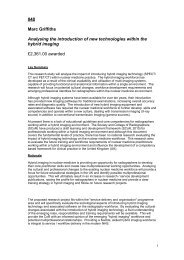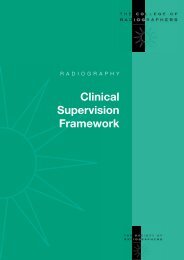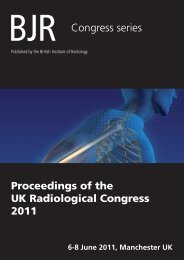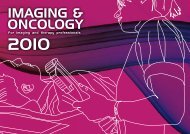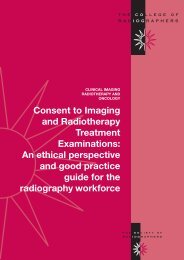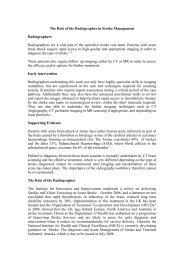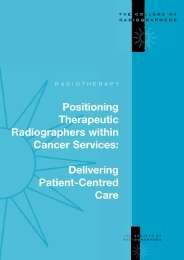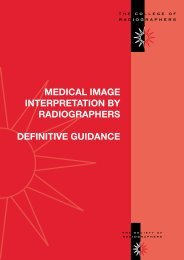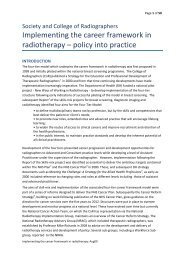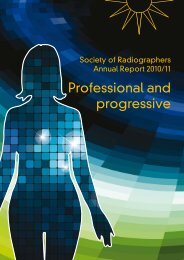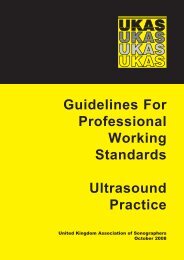SoR Brochure Child and Law SGG-82330 NEW - Society of ...
SoR Brochure Child and Law SGG-82330 NEW - Society of ...
SoR Brochure Child and Law SGG-82330 NEW - Society of ...
Create successful ePaper yourself
Turn your PDF publications into a flip-book with our unique Google optimized e-Paper software.
RADIOGRAPHYThe <strong>Child</strong> <strong>and</strong> the <strong>Law</strong>:The Roles <strong>and</strong>Responsibilities <strong>of</strong> theRadiographer
RADIOGRAPHYThe <strong>Child</strong> <strong>and</strong> the <strong>Law</strong>:The Roles <strong>and</strong> Responsibilities <strong>of</strong> the RadiographerResponsible Officer:Christina FreemanOctober 2005First editionISBN 1 871101 27 1£15 to SCoR members£25 non-membersThe <strong>Society</strong> <strong>of</strong> Radiographers207 Providence SquareMill StreetLondon SE1 2EWTelephone 020 7740 7200Facsimile: 020 7740 7233E-mail: info@sor.orgWebsite: www.sor.org3
ContentsForeword 5Executive Summary 61. The legal framework 72. Radiographic background 93. Initial concerns: Where a radiographer during normal daily work may have concerns 10about a child in his/her care4. Consent <strong>and</strong> confidentiality 125. Non-accidental injury <strong>and</strong> skeletal survey 156. Co-operation, distraction <strong>and</strong> immobilisation 177. Education <strong>and</strong> training 188. Looking after the children <strong>of</strong> patients 199. References <strong>and</strong> bibliography 20Appendix 1: Main principles <strong>of</strong> the <strong>Child</strong>ren Act 1989 23Appendix 2: Four broad categories <strong>of</strong> child abuse 23Appendix 3: Distraction techniques: providing distractions 244
Foreword“ Whether a nurse, doctor, dentist or allied health pr<strong>of</strong>essional, manager or administrator orclerical worker, the contribution <strong>of</strong> all health service workers to the protection <strong>of</strong> children iscrucial”(Barker & Hodes 2004) 1Articles related to the safety <strong>and</strong> protection <strong>of</strong> children are currently prominent in the media in theUK <strong>and</strong> elsewhere as a result <strong>of</strong>, <strong>and</strong> following on from, many high pr<strong>of</strong>ile cases including theClimbie inquiry <strong>and</strong> the more recent Jackson trial. The <strong>Society</strong> <strong>and</strong> College <strong>of</strong> Radiographers1995 document entitled The Implications for Radiographers <strong>of</strong> the <strong>Child</strong>ren Act 1989 was limitedto issues surrounding child consent for imaging <strong>and</strong> radiotherapy examinations. This presentpolicy document has gone further <strong>and</strong> refers to the legal framework as applied to the child <strong>and</strong>has examined the evidence in relationship to consent, non-accidental injury, <strong>and</strong> immobilisation <strong>of</strong>the child. In addition, it includes a section on the important issue <strong>of</strong> looking after the children <strong>of</strong>patients whilst they are in the department.This present document provides advice <strong>and</strong> guidance to the individual radiographer <strong>and</strong>recommendations related to education <strong>and</strong> training. It also outlines the requirement by managersto draw up referral guidelines for Non Accidental Imaging (NAI).Radiographers who wish to highlight the need for policy guidance <strong>and</strong> education <strong>and</strong> training inchild protection procedures <strong>and</strong> containment, may wish to forward a copy <strong>of</strong> this document tonamed executive directors on their employing authority board or governing body (additionalcopies available from Pr<strong>of</strong>essional Support).The <strong>Society</strong> <strong>and</strong> College <strong>of</strong> Radiographers is grateful to Val Challen, Radiographer <strong>and</strong> formerlyDirector <strong>of</strong> the Centre for the Development <strong>of</strong> Learning & Teaching, St Martin’s College Lancasterfor all her hard work in developing this advice document for the pr<strong>of</strong>ession. Val would like tothank Michaela Davis JP, Lecturer in Radiography, University College Dublin, for the generousprovision <strong>of</strong> her time <strong>and</strong> her considerable expertise <strong>and</strong> experience in child protection matterswhich has informed this document. Grateful thanks must also be given to Judith Hardwick,Paediatric Radiographer, formerly Superintendent Radiographer, Great Ormond Street Hospital for<strong>Child</strong>ren, London <strong>and</strong> to Liz Murphy, Superintendent Radiographer, Therapy Clinical Specialist forPaediatrics, Northern Centre for Cancer Treatment (NCCT), Newcastle General Hospital,Newcastle upon Tyne, for their very helpful <strong>and</strong> timely advice <strong>and</strong> guidance on a number <strong>of</strong>paediatric issues.5
Executive summaryPlease refer to content sections <strong>and</strong> sub sections for details.● Radiographers have personal <strong>and</strong> pr<strong>of</strong>essional responsibilities <strong>and</strong> duties in respect <strong>of</strong> theirdealings with children. (Section 1 subsections 1.7; 1.12; 1.15; 1.18)● It is important for all radiographers who come into contact with children that they are familiarwith the statutory proceedings which are in place for the care <strong>and</strong> protection <strong>of</strong> children.(Section 1 subsections 1.1; 1.2; 1.3; 1.10; 1.11; 1.16; 1.17)● Where there is concern that a child may be at risk <strong>of</strong> abuse <strong>and</strong> neglect, it is important thatradiographers act in accordance with the guidance provided in this document <strong>and</strong> with otherlocal <strong>and</strong> national protocols, The best interests <strong>of</strong> the child are paramount <strong>and</strong> it is incumbentupon the radiographer to ensure that the correct procedures are carried out. (Section 3subsections 3.3; 3.5; 3.8; 3.10; 3.13)● The radiographer may be the first person to suspect a case <strong>of</strong> non-accidental injury <strong>and</strong> s/hemust ensure that such concerns are raised with the appropriate persons. (Section 1subsection 1.7 <strong>and</strong> Section 3 subsections 3.2; 3.3; 3.4; 3.8; 3.10)● Any diagnostic images produced by the radiographer may form part <strong>of</strong> the significant evidentialdocumentation which may be presented in a court <strong>of</strong> law. Other documentation includeswritten reports which may include child disclosures <strong>and</strong> events which happened during theexamination. (Section 3 subsection 3.14 <strong>and</strong> Section 5 subsections 5.2; 5.3)● Radiographers must familiarise themselves with current legislation affecting their practice.(Section 1 <strong>and</strong> Section 4 subsection 4.1)● Advice concerning the imaging <strong>of</strong> children who are suspected <strong>of</strong> having been abused shouldbe sought from such agencies as the British <strong>Society</strong> <strong>of</strong> Paediatric Radiologists (BSPR) <strong>and</strong> theSenior Nurse in <strong>Child</strong> Protection. (Section 5 subsection 5.11; 5.17; 5.18 <strong>and</strong> Section 1subsection 1.14)● Local protocols for the imaging <strong>of</strong> children must be adhered to. Managers are required to drawup local referral guidelines for imaging for Non Accidental Injury (NAI)(Section 5 subsections5.1; 5.2; 5.7; 5.11; 5.12; 5.13; 5.14)● The radiographer is advised to seek verbal affirmation <strong>of</strong> consent to any procedure theyundertake on a patient. (Section 4 subsections 4.11; 4.12)● Radiation dose reduction to children should not be at the expense <strong>of</strong> obtaining incontrovertibleevidence <strong>of</strong> child abuse. (Section 5 subsection 5.15 <strong>and</strong> Section 6 subsection 6.12)● Immobilisation <strong>and</strong> restraint techniques on children should be used sparingly; distractiontechniques <strong>and</strong> play therapy should be attempted first. (Section 6 subsections 6.3; 6.8)● Pre registration curricula should include child psychology, child development, child protection<strong>and</strong> legal frameworks. (Section 7 subsections 7.3; 7.4)● <strong>Child</strong> protection training for radiographers should be part <strong>of</strong> an induction programme onappointment <strong>and</strong> be included as part <strong>of</strong> regular updates. (Section 7 subsection 7.2)● Radiographers <strong>and</strong> students should be aware <strong>of</strong> the implications <strong>of</strong> minding the children <strong>of</strong>patients. (Section 8 subsections 8.6; 8.7; 8.10)6
1. The legal framework1.1 The <strong>Child</strong>ren Act 1989 2 is a key piece <strong>of</strong> legislation applicable to Engl<strong>and</strong> <strong>and</strong> Walesdealing with the responsibilities <strong>of</strong> the state <strong>and</strong> <strong>of</strong> individuals to ensure the welfare <strong>of</strong>children <strong>and</strong> young people. It introduces orders which apply when children are at risk <strong>of</strong>‘significant harm’ <strong>and</strong> states that the welfare <strong>of</strong> the child is paramount (See appendix 1for the main principles <strong>of</strong> the <strong>Child</strong>ren Act 1989.)1.2 In Scotl<strong>and</strong> the <strong>Child</strong>ren (Scotl<strong>and</strong>) Act 1995 3 is the appropriate legislation <strong>and</strong> inNorthern Irel<strong>and</strong> the <strong>Child</strong>ren (Northern Irel<strong>and</strong>) Order 1995 4 . There are some differencesbetween the Acts in relationship to approaches to child protection <strong>and</strong> radiographers areadvised to ensure they are familiar with the legislation appropriate to the country in whichthey work.1.3 The concept <strong>of</strong> ‘significant harm’ 5 is the threshold that justifies compulsory interventionin child protection cases in the best interests <strong>of</strong> the child. Under section 31 (9) <strong>of</strong> the<strong>Child</strong>ren Act 1989 'harm' means ill-treatment or the impairment <strong>of</strong> health or development.There are, however, no criteria for judging what constitutes significant harm. It can be asingle traumatic act such as a violent assault, suffocation, shaking or poisoning, or itcould be an accumulation <strong>of</strong> events such as neglect, emotional, physical or sexual abusethat has the effect <strong>of</strong> damaging the child’s psychological <strong>and</strong>/or physical development.1.4 In January 2003 the Victoria Climbié inquiry report by Lord Laming noted the seriousshortcomings in communication between health pr<strong>of</strong>essionals <strong>and</strong> between agenciesinvolved in child protection despite the guidance provided in the 1999 national frameworkfor child protection practice Working together to safeguard children: a guide tointeragency working to safeguard <strong>and</strong> promote the welfare <strong>of</strong> children. 61.5 The Climbié inquiry emphasised the importance <strong>of</strong> pr<strong>of</strong>essions <strong>and</strong> others workingtogether <strong>and</strong> sharing information in order to keep children safe from harm 7 . Four broadcategories <strong>of</strong> abuse defined in Working Together are physical abuse, emotional abuse,sexual abuse <strong>and</strong> neglect. (See appendix 2 for an explanation <strong>of</strong> the four broadcategories.)1.6 As a result <strong>of</strong> the Climbié inquiry, the government published revised guidance for allpr<strong>of</strong>essionals directly involved in child protection. This document What to do if you areworried a child is being abused 8 provides a condensed version <strong>of</strong> the Working Togetherdocument to assist pr<strong>of</strong>essionals working in the front line to respond appropriately if theysuspect child abuse <strong>and</strong>/or neglect.1.7 What to do if you are worried a child is being abused is also a valuable resource for allhealth practitioners including radiographers who come into contact with children <strong>and</strong>families in their everyday work <strong>and</strong> who thus have a duty to safeguard <strong>and</strong> promote thewelfare <strong>of</strong> children. It provides guidance (later reflected in this present document) forthose practitioners, such as radiographers, who do not have a direct specific role inrelation to child protection but do play a role in the protection <strong>of</strong> children.1.8 The Scottish equivalents <strong>of</strong> some <strong>of</strong> these documents are the Scottish Office Protecting<strong>Child</strong>ren. A Shared Responsibility: guidance on interagency cooperation 1998 9 <strong>and</strong> theScottish Executive Protecting <strong>Child</strong>ren. A Shared Responsibility: guidance for healthpr<strong>of</strong>essionals 2000 10 .1.9 Prompted by both the Climbié inquiry <strong>and</strong> the Bristol Royal Infirmary inquiry, inSeptember 2003 the government published the Green Paper Every <strong>Child</strong> Matters 11which called for a radical improvement in the opportunities <strong>and</strong> outcomes for children tobe driven by changes in the delivery <strong>of</strong> children’s services in order to maximiseopportunities <strong>and</strong> minimise risk for every child 12 .7
1.10 The government introduced The <strong>Child</strong>ren Bill into the House <strong>of</strong> Lords in March 2004 toprovide the legislative framework for taking forward the Green Paper Every <strong>Child</strong> Matters.This Bill received Royal Assent on 15 November 2004 <strong>and</strong> is now the <strong>Child</strong>ren Act2004 13 . Under this Act, there is a statutory duty for agencies to work together. Pleasenote that it is not a rewrite <strong>of</strong> the <strong>Child</strong>ren Act 1989. The overall aim <strong>of</strong> the 2004 Act is toencourage integrated planning, commissioning <strong>and</strong> delivery <strong>of</strong> services as well asimprove multi-disciplinary working, remove duplication, increase accountability <strong>and</strong>improve the co-ordination <strong>of</strong> individual <strong>and</strong> joint inspections in local authorities 14 .1.11 The <strong>Child</strong>ren Act 2004 places a new statutory duty on those agencies providing servicesto children, including NHS bodies, to establish Local Safeguarding <strong>Child</strong>ren Boards(LSCBs) to replace by April 2006 the voluntary Area <strong>Child</strong> Protection Committees(ACPCs), which are, at this time <strong>of</strong> writing, in place.1.12 Radiographers should ensure they underst<strong>and</strong> under Section 11 <strong>of</strong> the <strong>Child</strong>ren Act 2004that their employing authority has a duty to safeguard <strong>and</strong> promote the welfare <strong>of</strong>children <strong>and</strong> that, as employees <strong>and</strong> as pr<strong>of</strong>essionals, they must play this important parttoo.1.13 The responsibility for child protection services across all health service providers lies withthe Primary Care Trusts (PCTs) in Engl<strong>and</strong> who appoint a designated doctor <strong>and</strong> nurse totake the strategic lead in all aspects <strong>of</strong> the health service contribution to safeguardingchildren, including child protection matters. They represent the health service on the localACPCs/LSCPs.1.14 In addition, each NHS Trust, including PCTs, must appoint a named doctor <strong>and</strong> a namednurse to take the pr<strong>of</strong>essional lead on child protection issues within their respectivetrusts. They are the principal points <strong>of</strong> contact for advice <strong>and</strong> opinion for health staffmembers who may have suspicions or concerns. They also organise <strong>and</strong> run training <strong>and</strong>information sessions for members <strong>of</strong> staff.1.15 Radiography managers must make it very clear that the pr<strong>of</strong>essional responsibilities <strong>of</strong>radiographers with regard to children make it imperative that they attend child protectiontraining sessions on a regular basis, both on initial appointment as part <strong>of</strong> an inductionprogramme <strong>and</strong> later as part <strong>of</strong> their routine (preferably annual) updates. (See alsosection 7.)1.16 The UK ratified the UN Convention on the Rights <strong>of</strong> the <strong>Child</strong> in 1991 15 . The Conventionsets out st<strong>and</strong>ards that should be reflected in health care <strong>and</strong> particularly in Article 3which states that “ any decision or action affecting children……..should be focused ontheir best interests”.1.17 Radiographers should bear in mind that the rights <strong>of</strong> children <strong>and</strong> their parents under theHuman Rights Act 1998 16 will have a bearing on child protection issues. The Articleswhich may have a bearing are Article 2, the right to life, Article 3, the prohibition <strong>of</strong>torture, inhuman or degrading treatment or punishment, Article 6, right to a fair trial <strong>and</strong>Article 8, respect for private <strong>and</strong> family life.1.18 Because child protection is everyone’s responsibility, this important area has to comewithin the remit <strong>of</strong> every radiographer’s personal <strong>and</strong> pr<strong>of</strong>essional duties.8
2. Radiographic background2.1 It is now some 10 years since the <strong>Society</strong> <strong>and</strong> College <strong>of</strong> Radiographers (SCoR)published a guidance leaflet The Implications for Radiographers <strong>of</strong> the <strong>Child</strong>ren Act1989 17 which dealt mainly with consent issues. This present guidance is designed tocover wider issues <strong>and</strong> the responsibilities <strong>of</strong> every radiographer.2.2 Both Hancock et al in 1997 18 <strong>and</strong> Sudbery et al 1994 19 have emphasised theimportance for radiographers to have knowledge <strong>of</strong> the <strong>Child</strong>ren Act 1989 <strong>and</strong> thatradiographers require knowledge <strong>of</strong> not only the technical <strong>and</strong> radiological elements, butalso the social, emotional <strong>and</strong> legal contexts <strong>of</strong> child abuse.2.3 Several radiographers <strong>and</strong> others (notably Brown & Henwood 1997 20 ; Hogg et al 1999 21 ;Drummond & York 2001 22 ; Dimond 2002 23 ; Rigney & Davis 2004 24 ; Davis & Reeves2004 25 ; Hardwick & Gyll 2004 26 ; have written extensively on issues related toradiography, child abuse <strong>and</strong> non-accidental injury <strong>and</strong> have provided a number <strong>of</strong>recommendations for radiographers working with children. Many <strong>of</strong> theserecommendations have informed this present guidance document.2.4 In 1999 the SCoR published guidelines on aspects <strong>of</strong> forensic radiography in theGuidance for the Provision <strong>of</strong> Forensic Radiography Services. Forensic medicine refers tothe application <strong>of</strong> medical knowledge in the collection <strong>of</strong> evidence [including radiographicevidence] which may be called upon to be used in a court <strong>of</strong> law. See section 5 <strong>of</strong> thispresent document for further reference to the SCoR guidelines in relation to imaging incases <strong>of</strong> suspected non-accidental injury.9
3. Initial Concerns: Where a radiographer during normal dailywork may have concerns about a child in his/her care3.1 Research undertaken by the NSPCC shows that a significant minority <strong>of</strong> children in the UKsuffer serious abuse <strong>and</strong> neglect with 16 per cent <strong>of</strong> children experiencing seriousmaltreatment by parents 27 . Figures from 2003 showed that in that year there were 32,700children on child protection registers in the UK 28 .3.2 Figures like this mean that radiographers may come across potential or actual instances <strong>of</strong>child abuse <strong>and</strong> neglect in their normal daily work. When carrying out any examinations onchildren radiographers must be cognisant <strong>of</strong> the possibility <strong>and</strong> must be vigilant.Radiographers should familiarise themselves with local procedures for safeguarding thewelfare <strong>of</strong> children. They should find out where they are kept in the department <strong>and</strong> ensurethat they have read them.3.3. The child protection responsibilities <strong>of</strong> the radiographer are defined into two distinctcategories:3.3.1. Personal <strong>and</strong> pr<strong>of</strong>essional protection <strong>of</strong> the child3.3.2. Undertaking imaging for diagnostic, clinical <strong>and</strong> evidential purposes.Under either category the main priority is the child’s safety 21 .3.4 As part <strong>of</strong> the routine care <strong>of</strong> children, radiographers (therapeutic <strong>and</strong> diagnostic) are <strong>of</strong>tenwell placed to detect the possible signs <strong>of</strong> physical abuse where suspicions may bearoused both from appearances in the images produced <strong>and</strong> from marks on the child’sbody, eg bruising, cigarette burns, strap/belt marks. The younger the child, the more theyare at risk from physical harm <strong>and</strong>, in this age range, injuries to the head, eyes, ears <strong>and</strong>mouth should be viewed with suspicion.3.5 The diagnostic radiographer is also in a position to ascertain whether the radiographicappearance <strong>of</strong> any injury is consistent with the explanation provided by the child, the parentor the carer. Previous x-ray images taken at the hospital should be sought. Anyconcerns/suspicions must be drawn to the attention <strong>of</strong> the appropriate persons (see 3.8).The radiographer should not assume that other health care workers might have reportedsuch; it is better that two (or more) persons voice suspicions than none.3.6 Also, if the radiographer has concerns/suspicions that the sibling <strong>of</strong> a child being examinedor the child <strong>of</strong> one <strong>of</strong> her/his patients is being abused s/he must draw these concerns tothe attention <strong>of</strong> appropriate persons (see section 3.8). The radiographer should not assumethat other health care workers might have reported such; again it is better that two (ormore) persons voice suspicions than none.3.7 If the radiographer has any concerns (see sections 3.4 <strong>and</strong> 3.5) s/he should underst<strong>and</strong>that the hospital trust has child protection procedures which must be followed (see section1.14). The Climbié inquiry emphasised the importance <strong>of</strong> pr<strong>of</strong>essionals sharing informationin order to keep children safe from harm.3.8 In the event <strong>of</strong> any concerns, the radiographer must:3.8.1. Discuss immediately any concerns initially with a senior member <strong>of</strong> staff. In theevent <strong>of</strong> working single h<strong>and</strong>ed that staff member may be outside the clinicaldepartment.3.8.2. Immediately make a detailed record <strong>of</strong> the observations leading to suspicion <strong>and</strong>the action taken. This record must show timings, be dated, signed <strong>and</strong> witnessed<strong>and</strong> a copy kept in safe keeping in the department.3.8.3. Contact one <strong>of</strong> the named persons identified as a member <strong>of</strong> the NHS Trust childprotection team (or equivalent in the private sector) <strong>and</strong> provide them with a copy<strong>of</strong> the record made.10
3.9 In addition, the radiographer may have concerns raised by the behaviour <strong>of</strong> the child duringthe examination or through the words spoken by the child either with a parent/carer inattendance or more usually when s/he is alone with the radiographer.3.10 If the child does confide in the radiographer s/he must be careful to avoid asking questions<strong>of</strong> the child as, should the case go to litigation, they might be construed as leadingquestions <strong>and</strong> might complicate early investigations with the police. The radiographershould listen carefully <strong>and</strong> record verbatim the whole discourse as soon as possible; notesshould also be recorded <strong>of</strong> the child’s demeanor during the discourse. Davis 29recommends that a child disclosing any information must not be stopped <strong>and</strong> theradiographer should not promise to keep secret the information. The radiographer mustlisten carefully <strong>and</strong> not make assumptions about or interpret what the child is saying. Therecord, which must be in a clear <strong>and</strong> comprehensible format, must show timings, be dated,signed <strong>and</strong> witnessed <strong>and</strong> signed by another pr<strong>of</strong>essional as soon as practicable. Theradiographer should then discuss the event with a senior member <strong>of</strong> staff to let them knowwhat has occurred <strong>and</strong> then contact one <strong>of</strong> the named persons identified as a member <strong>of</strong>the employing authority’s child protection team.3.11 At this point, the role <strong>of</strong> the radiographer has been fulfilled. It is not the responsibility <strong>of</strong> theradiographers to inform parents or carers <strong>of</strong> suspected abuse nor is it their responsibility toinvestigate. The child protection team member will decide whether Social Services need becontacted.3.12 The radiographer should, however, expect feedback from the child protection team <strong>and</strong>investigate the extent to which his/her report has been acted upon. Service managersshould assist the radiographer in this respect.3.13 Radiographers should be mindful <strong>of</strong> the fact that students must be supervised at all times.In the event <strong>of</strong> any situation where a student radiographer undertaking a proceduresuspects abuse, the procedure should be halted <strong>and</strong> the student report any suspicions tothe supervising radiographer who should then relieve the student from the examination <strong>and</strong>ask the student to withdraw. The radiographer should follow the procedure as outlined insection 3.8. In addition, the student should complete a separate signed statement <strong>of</strong>his/her suspicions <strong>and</strong> the action taken. This statement must be appended to theradiographer’s report.3.14 The images produced as a result <strong>of</strong> the examination <strong>and</strong> the signed record form part <strong>of</strong>what Hancock et al 1997 18 terms the significant evidential documents. Suchdocumentation may also be supplemented by further images forming part <strong>of</strong> a skeletalsurvey examination (see section 5 <strong>of</strong> this present document).3.15 The awareness by the radiographer <strong>of</strong> the child protection procedures which are in placecannot be stressed too much as the safety <strong>and</strong> protection <strong>of</strong> children must be the firstpriority.3.16 Radiographers will, <strong>of</strong> course, be anxious about disclosures <strong>and</strong> worry about what wouldhappen if they were wrong about their suspicion <strong>of</strong> child abuse. On 21 April 2005 theHouse <strong>of</strong> Lords delivered judgment in a test case brought by parents who had beensuspected <strong>of</strong> inflicting non-accidental injury, sexual abuse <strong>and</strong> Munchausen’s Syndrome byProxy (JD [FC] v. East Berkshire Community Hospital NHS Trust <strong>and</strong> Others 2005). TheHouse <strong>of</strong> Lords has ruled that parents wrongly accused <strong>of</strong> abusing a child cannot suedoctors or social workers. They ruled that in raising such a suspicion the doctor’s soleconcern should be the welfare <strong>of</strong> the child. The health pr<strong>of</strong>essional’s common law duty <strong>of</strong>care is to the child <strong>and</strong> not to the parent. The above is also relevant to radiographers.3.17 Usually, radiographers would not have access to the <strong>Child</strong> Protection register but, ifsuspicious <strong>of</strong> abuse, the radiographer should make efforts to find out if the child has beenx-rayed previously perhaps under another name or date <strong>of</strong> birth <strong>and</strong> to routinely review anyprevious images for possible radiographic signs which may lead to suspected nonaccidental injury.11
4. Consent <strong>and</strong> Confidentiality4.1 The legal framework upholding consent <strong>and</strong> confidentiality issues as far as children isconcerned is complex but this should not be a barrier to radiographers becoming aware<strong>of</strong> where their pr<strong>of</strong>essional responsibilities lie <strong>and</strong> acting upon them. In addition, it is theduty <strong>of</strong> any health care practitioner to keep him/herself informed <strong>of</strong> any legaldevelopments that may impact on their practice. This is what being a pr<strong>of</strong>essional means<strong>and</strong> distinguishes the pr<strong>of</strong>essional from the non-pr<strong>of</strong>essional.4.2 Patient confidentiality is a fundamental feature <strong>of</strong> pr<strong>of</strong>essional practice. Where the child isconcerned, <strong>and</strong> in particular when in relation to child protection, the key featuresurrounding confidentiality is that the interests <strong>of</strong> the child in question are paramount <strong>and</strong>may supercede all other considerations (<strong>Child</strong>ren Act 1989).4.3 The Health Pr<strong>of</strong>essions Council (HPC) document ‘St<strong>and</strong>ards <strong>of</strong> conduct, performance<strong>and</strong> ethics’ 30 which applies to all registered members <strong>of</strong> the HPC, indicates that it ispossible to release personal or confidential information to anyone entitled to it <strong>and</strong> thatinformation about a patient must only be used to continue to care for that person.Indeed, the <strong>Child</strong>ren Act 1989 makes it clear that in any situation, the child’s welfare isparamount.4.4 All NHS Trusts, PCTs <strong>and</strong> health authorities <strong>and</strong> their employees have a statutory duty toassist Social Services making enquiries under the <strong>Child</strong>ren Act 1989 [or <strong>Child</strong>ren(Scotl<strong>and</strong>) Act 1995 or <strong>Child</strong>ren (Northern Irel<strong>and</strong>) Order 1995].4.5 Conducting such enquiries requires relevant information about the child. Consent todisclosure should 31 be obtained but disclosure without consent should be restricted tothe minimum that will serve the purpose, disclosed only to someone who holds a similarduty <strong>of</strong> confidentiality on a need to know basis.4.6 The Department <strong>of</strong> Health 2001 documentation 32 states that “Obtaining consent beforeproviding care is both a fundamental part <strong>of</strong> good practice <strong>and</strong> is a legal requirement”.4.7 The principle <strong>of</strong> consent to an examination carried out by a health pr<strong>of</strong>essional is the right<strong>of</strong> patients to determine what happens to their bodies <strong>and</strong> the radiographer (in commonwith all other healthcare pr<strong>of</strong>essionals) who does not respect this principle is liable toboth legal action by the patient <strong>and</strong> action by the HPC.4.8 For consent to be valid <strong>and</strong> legal, three elements must be satisfiedi) The patient must be legally competent;ii) The consent must be freely given;iii) The person consenting must be suitably informed 33 .4.9 Valid legal consent to treatment or examination can be express consent (oral or written)or implied consent. The radiographer must gain the consent <strong>of</strong> a patient to the procedurethey will undertake.4.10 Express consent is needed for treatments <strong>and</strong> investigative procedures which carry anyrisks; this must, by definition, include radiological/radiotherapeutic procedures. The law,however, does not require consent to be in written form, verbal consent is acceptable solong as the three elements above (see section 4.8) have been satisfied.12
4.11 Implied consent is an agreement signaled by the behaviour <strong>of</strong> an informed patient, whomay not express him/herself verbally but does as requested by the radiographer. Thegiving <strong>of</strong> information to the patient distinguishes implied consent from compliance with arequest (eg lying on an x-ray couch or presenting an arm for an injection). Theradiographer, like the nurse, is well advised to seek the verbal affirmation <strong>of</strong> a patient priorto undertaking any procedure 34 .4.12 If children are competent to give consent for themselves for either an examination or adisclosure, the radiographer should seek consent directly from them. The legal positionon competence is different for children under 16 years <strong>of</strong> age <strong>and</strong> for those over 16.4.13 Legally a child is a person who has not yet attained the age <strong>of</strong> 18 years, but by virtue <strong>of</strong>Section 8 <strong>of</strong> the Family <strong>Law</strong> Reform Act 1969 35 children aged 16 - 17 years are deemedcapable <strong>and</strong> therefore competent to give consent in the same way as an adult. It ishowever prudent for the radiographer to encourage children <strong>of</strong> this age to involve theirfamilies in the decision making process unless the radiographer believes that it not in thebest interests <strong>of</strong> the child to do so.4.14 For children under the age <strong>of</strong> 16 years, competence to consent may not be presumed; achild under 16 will be competent to give valid consent if they have “sufficientunderst<strong>and</strong>ing <strong>and</strong> intelligence to enable him/her to underst<strong>and</strong> fully what is proposed” 36(known as either Gillick competence or Fraser ruling competence).4.15 Criteria for judging Gillick competence <strong>and</strong> the lower age range are not clear <strong>and</strong>radiographers are advised that “legal capacity by a child varies according to the particularmatter <strong>and</strong> maturity <strong>and</strong> underst<strong>and</strong>ing <strong>of</strong> the particular young person” 37 . Although thereis no clear legal guidance, it would appear to be unlikely that the courts would considerchildren <strong>of</strong> 13 years <strong>and</strong> under to be Gillick competent 38 . This however may well dependon the nature <strong>of</strong> the procedure to be undertaken. It is important, therefore, forradiographers to recognise that they must exercise pr<strong>of</strong>essional judgement in this regardeach time they carry out a diagnostic examination or treatment procedure.4.16 Gillick ruling does not apply in Scotl<strong>and</strong>. Young people in Scotl<strong>and</strong> have a statutory rightto give their own consent to treatment. Section 2 (4) <strong>of</strong> the Age <strong>of</strong> Legal Capacity(Scotl<strong>and</strong>) Act 1991 39 allows a young person with no specified age range to consent onhis or her own behalf to a medical procedure provided that, in the opinion <strong>of</strong> a qualifiedmedical practitioner, s/he is capable <strong>of</strong> underst<strong>and</strong>ing the nature <strong>and</strong> possibleconsequences <strong>of</strong> the treatment <strong>and</strong> is owed the same duty <strong>of</strong> confidentiality as an adultunless the doctor suspects abuse 40 .4.17 If a Gillick (Fraser) competent child consents to a procedure, a parent cannot over ridethat consent, however a parent can consent to a procedure should a Gillick (Fraser)competent child refuse.4.18 In relation to examinations <strong>of</strong> a child there are several issues that the radiographer mustaddress, consent to an examination <strong>of</strong> suspected non accidental injury (NAI) <strong>and</strong> consentto disclosure <strong>of</strong> information gained by the radiographer in the course <strong>of</strong> his/herpr<strong>of</strong>essional activity. Disclosure <strong>of</strong> information relates to confidentiality principles <strong>and</strong> is apotential source <strong>of</strong> worry for all pr<strong>of</strong>essionals. Technically, disclosure can be construed asa pr<strong>of</strong>essional breach <strong>of</strong> confidentiality (see section 4.3) but in cases <strong>of</strong> suspected childabuse it can be justified, allowing disclosure to the appropriate person or agency (see<strong>Child</strong>ren Act 1989).13
4.19 Radiographers may be concerned about disclosing any information gained by themabout a child during a diagnostic imaging/radiotherapy treatment. They are not alone;nursing research carried out in Northern Irel<strong>and</strong> in 2003/04 found that healthpr<strong>of</strong>essionals are failing to report suspicious physical child abuse due to the fear <strong>of</strong>litigation, misdiagnosis <strong>and</strong> a lack <strong>of</strong> knowledge about the procedures <strong>of</strong> reporting 41 .These anxieties should be dealt with through thorough, appropriate <strong>and</strong> timely education<strong>and</strong> training, as well as pr<strong>of</strong>essional support.4.20 Consent to disclosure should normally be sought from a competent child <strong>and</strong>parent/carer, unless so doing would place that child, or indeed a sibling, at greater risk.4.21 The radiographer should disclose information about a non-competent child if s/he feelsthat failure to do so may place the child at risk <strong>of</strong> death or serious harm or where theinformation would help to prevent, detect or prosecute a serious crime.4.22 The radiographer should always record when, what <strong>and</strong> why information has beenshared <strong>and</strong> with whom, in order that they are able to justify their decision at a later date.4.23 In the event <strong>of</strong> a suspected NAI, a skeletal survey may be requested by a paediatrician.The parent/carer or competent child would need to know the reasons behind therequest. A paediatrician or a paediatric radiologist should be the person explaining therequest <strong>and</strong> seeking consent. Thus, it is not the role <strong>of</strong> the radiographer to seek initialconsent for the examination, but the radiographer should always reaffirm consent oncontact with the child <strong>and</strong> parent/carer.4.24 In the event <strong>of</strong> a parent/carer or competent child subsequently refusing consent to theexamination once in the clinical imaging department, the radiographer will need to liaisewith the requesting physician. If further discussion with the persons holding parentalresponsibility does not lead to consent then it is likely that the local authority wouldultimately make an application for a court order under the <strong>Child</strong>ren Act 1989 for theprocedure to be carried out in the best interests <strong>of</strong> the child.14
5. Non-accidental injury <strong>and</strong> skeletal survey5.1 Radiographers should note that usually, referrals to the clinical imaging department for askeletal survey should only be accepted from a paediatrician or a radiologist usually afteradmission <strong>of</strong> the child.5.2 Images produced may form part <strong>of</strong> the documentary diagnostic evidence in childprotection cases, criminal proceedings <strong>and</strong> other forms <strong>of</strong> litigation 42 .5.3 Radiographers must be aware that the diagnostic images produced in cases <strong>of</strong> nonaccidental injury examinations form part <strong>of</strong> the so-called forensic evidence. The 1999SCoR document ‘Guidance for the Provision <strong>of</strong> Forensic Radiography Services’ 43 clearlyoutlines the medico-legal aspects related to admissible evidence <strong>and</strong> provides a number<strong>of</strong> guidelines for radiographers to ensure the authentication <strong>and</strong> continuity <strong>of</strong> suchevidence. Radiographers should familiarise themselves with Section 10 <strong>of</strong> the 1999document.5.4 Radiographic markers must be photographed onto the image in order for an image to beregarded as a legal document 25 . Date <strong>and</strong> time <strong>of</strong> the examination, initials/name <strong>of</strong>radiographer <strong>and</strong> witness (usually 2nd radiographer) <strong>and</strong> appropriate markers must alsobe recorded on the image at the time <strong>of</strong> the examination 43 .5.5 Images may also provide information that points to alternative diagnoses, egosteogenesis imperfecta or temporary brittle bone disease (TBBD).5.6 Hardwick & Gyll (2004) advise that skeletal surveys should ideally be carried out by aradiographer trained in radiographic paediatric procedures 26 , but this may not always bepossible.5.7 In order to reduce the emotional impact on the child, the parent/carer <strong>and</strong> theradiographer, the time allocation <strong>and</strong> the place where the skeletal survey is to beundertaken must be carefully managed. The procedure should never be rushed.5.8 It has been indicated that most child abuse imaging protocols now require that theprocedure be carried out by two radiographers to, not least, act as witnesses for oneanother 25 . Should this not be possible, the radiographer should be accompanied at alltimes by a second pr<strong>of</strong>essional, eg a nurse who may have accompanied the child <strong>and</strong>the parent/carer to the department or a social worker.5.9 The radiographer(s) undertaking the examination may also be sought as potentialwitnesses to the absence <strong>of</strong> certain physical [or if appropriate to their role, imageidentifiable]injuries should the matter be attested in court. The radiographer(s) should, asa matter <strong>of</strong> routine, record what they observe <strong>of</strong> the child’s body including, if appropriate,the absence <strong>of</strong> any physical signs <strong>of</strong> injury 25 .5.10 The radiographer should note that the child may be accompanied by a parent or carerduring the imaging procedure [unless it is not in the best interests <strong>of</strong> the child]. Theradiographer must avoid any judgmental approach in either words or deeds towardsparents/carers.5.11 Please see section 3.10 above on how to react should the child start talking about thebackground to his/her injuries. It is not appropriate to promise the child to keep anyinformation confidential.15
5.12 The British <strong>Society</strong> <strong>of</strong> Paediatric Radiologists (BSPR) has produced guidelines in the form<strong>of</strong> st<strong>and</strong>ards for skeletal surveys in suspected NAI. These are available via their website 42 .The guidelines include technical st<strong>and</strong>ards for technique, procedural st<strong>and</strong>ards, targetsfor outcome <strong>and</strong> image protocols.5.13 The <strong>Society</strong> & College <strong>of</strong> Radiographers expects each department in the UK to draw upclear referral guidelines for NAI <strong>and</strong> that such guidelines be available <strong>and</strong> easilyaccessible by radiographers. Managers are advised to use the BSPR st<strong>and</strong>ards <strong>and</strong>guidelines as a starting point. It is a managerial responsibility for the development <strong>and</strong>publication <strong>of</strong> these departmental guidelines.5.14 Kleinman et al (2004) 44 in the USA <strong>and</strong> others in the UK [James et al (2003) 45 ; Offiah &Hall (2003) 46 ; Carty (2003) 47 ] have all noted that in hospitals imaging protocols forsuspected NAI vary considerably as does, even more importantly, the diagnostic quality<strong>of</strong> the images.5.15 Brown & Henwood (1997) warn that failure to follow protocols laid down by hospitals maycause any images produced to be inadmissible should the case be heard in a court <strong>of</strong>law 20 .5.16 A so called “Babygram” (imaging that encompasses the whole child on 1 or 2radiographic exposures) plays no role in the imaging <strong>of</strong> children as it does not provide therequisite information about the specific <strong>and</strong> subtle abnormalities in cases <strong>of</strong> suspectedabuse. [Carty identifies that the total effective dose from a BSPR recommended survey is0.22mSv for a maximum <strong>of</strong> 22 exposures 47 ].5.17 The balance <strong>of</strong> the importance between retaining acceptable diagnostic image quality,whilst at the same time keeping the dose as low as reasonably practicable must beconsidered by the radiographer. It is preferable that a set <strong>of</strong> good quality images beproduced through the administration <strong>of</strong> a sufficient dose <strong>of</strong> radiation than the diagnosisbe uncertain <strong>and</strong> the child returned to a high risk environment.5.18 Doses must be within published diagnostic reference levels (DRLs) for children but dosereduction must not be at the expense <strong>of</strong> providing incontrovertible evidence <strong>of</strong> childabuse. The radiographer should record the exposure settings making a clinical evaluation<strong>of</strong> the outcome <strong>of</strong> the exposures.5.19 The BSPR recommend that computed radiography (CR) or direct digital radiographysystems may used provided that dedicated paediatric s<strong>of</strong>tware is available 42 .5.20 The <strong>Society</strong> & College <strong>of</strong> Radiographers recommends that hard copies be created at thesame time as those <strong>of</strong> digitally stored images. This will help prevent the possibility <strong>of</strong> thecreation <strong>of</strong> manipulated images being used in evidence. The valid images will then be thehard copy images which must be authenticated in the normal way 43 .16
6. Co-operation, distraction <strong>and</strong> immobilisation6.1 <strong>Child</strong>ren are <strong>of</strong>ten unable to fully co-operate with health pr<strong>of</strong>essionals during diagnosticimaging or radiotherapy treatment. This may be due to their age, their lack <strong>of</strong> underst<strong>and</strong>ing <strong>of</strong>what is required <strong>of</strong> them, the type <strong>of</strong> procedure, the degree <strong>of</strong> urgency in carrying out theprocedure <strong>and</strong> fear <strong>of</strong> the unknown <strong>and</strong> <strong>of</strong> the equipment <strong>and</strong> <strong>of</strong> the staff 48 .6.2 Restraining children from moving or restricting their movement in order to carry out a diagnosticexamination should be carefully considered by the radiographer. The radiographer shouldweigh up the situation <strong>and</strong> anticipate the possible need for the person in attendance [preferablya parent] to hold the child still for the procedure whilst at the same time give consideration <strong>of</strong>ways to prevent the need to restrain.6.3 The need for restraint can be prevented through giving clear information, throughencouragement <strong>of</strong> the child <strong>and</strong> the parent <strong>and</strong> gaining their confidence, through the use <strong>of</strong>distraction techniques 49 appropriate to the age <strong>of</strong> the child <strong>and</strong> through constructive play.Restraint must be the last resort <strong>and</strong> in the best interests <strong>of</strong> the child 26 . Distraction is alwayspreferable.6.4 Distractions will be different dependent upon the age <strong>of</strong> the child, although the ability <strong>of</strong> a childto think <strong>and</strong> develop cannot always be understood outside the social & cultural contexts inwhich the child exists 50 . This may make it difficult for the radiographer to underst<strong>and</strong> theviewpoint <strong>of</strong> the child.6.5 The radiographer should be cognisant <strong>of</strong> the language s/he uses to describe the radiographicprocess as children make literal interpretations <strong>of</strong> words such as film, cassette, slice <strong>and</strong> cut inconnection with diagnostic examinations <strong>and</strong> tattoo <strong>and</strong> fields with regard to therapeuticprocedures.6.6 Radiographers undertaking diagnostic examinations on children are advised to enlist theassistance <strong>of</strong> play specialists employed by the hospital who will be able to provide support ifsufficient notice <strong>of</strong> their attendance is provided. This is especially important for NAIexaminations.6.7 For therapeutic procedures involving children, the National Institute for Health <strong>and</strong> ClinicalExcellence (NICE) report Service guidance for improving outcomes in children <strong>and</strong> youngpeople with cancer 51 recommends the involvement <strong>of</strong> play specialists during the planningstages which may later prevent the need for anaesthesia during the treatment stages.6.8 Should immobilisation be the only way forward, consent to immobilisation should be soughtfrom both the child, if competent to underst<strong>and</strong>, <strong>and</strong> from the parent/carer. The proposedmethod <strong>of</strong> immobilisation must be fully discussed in non-technical language with theparent/carer <strong>and</strong> the opportunity for questions from them must be provided. The radiographershould familiarise him/herself regarding local restraint policies.6.9 The radiographer must be aware that any child may exhibit distress when immobilisation isapplied but that a child who may have been at the receiving end <strong>of</strong> physical abuse mayexperience ‘flashbacks’ which may be psychologically damaging.6.10 Gentle, protective restriction <strong>of</strong> the child with pads <strong>and</strong> other devices to maintain the correctposition is acceptable so long as the radiographer prepares both the child <strong>and</strong> the parent/carer.6.11 Hardy & Armitage 2002 caution healthcare pr<strong>of</strong>essionals to ‘familiarise themselves with thelegal <strong>and</strong> ethical implications <strong>of</strong> restraining or immobilising children <strong>and</strong> develop a systematicapproach to this aspect <strong>of</strong> practice’ 52 .6.12 Correct positioning <strong>of</strong> children is difficult in order to provide the quality <strong>of</strong> image to detect <strong>of</strong>tensubtle signs <strong>of</strong> injury. The fact that the image was taken from a non-cooperative child is noexcuse for the production <strong>of</strong> an inferior quality film 53 .17
7. Education <strong>and</strong> training7.1 It would appear from the research carried out by Davis <strong>and</strong> others that radiographers are<strong>of</strong>ten omitted from child protection training sessions carried out in their place <strong>of</strong>employment. This must be urgently addressed. The Royal College <strong>of</strong> Nursing (RCN) arguesthat there should be m<strong>and</strong>atory child protection training for all health care workers whocome into contact with children <strong>and</strong> young people, this must include ancillary <strong>and</strong> <strong>of</strong>ficestaff 54 .7.2 <strong>Child</strong> protection training for radiographers, <strong>and</strong> other members <strong>of</strong> staff appointed to theradiology/radiotherapy department, should be provided as part <strong>of</strong> an induction programmeon appointment <strong>and</strong> updated on a regular basis.7.3 Issues surrounding child protection should be integrated into the curriculum in all preregistration radiography programmes. Assistant practitioner courses should ensure thatlearners on such courses attend the child protection training provided by their employer.7.4 Pre registration curricula should include issues surrounding child psychology <strong>and</strong> socialpsychology, including child development.7.5 The identification <strong>of</strong> the external physical signs <strong>and</strong> the subtle radiographic signs <strong>of</strong> nonaccidentalinjury must be part <strong>of</strong> the pre registration curriculum. Pre registration curriculashould also include imaging protocols <strong>and</strong> the issues surrounding the collection <strong>of</strong>evidence.7.6 Radiographers who undertake forensic radiography examinations, including NAI cases,must be educated <strong>and</strong> trained in all aspects <strong>of</strong> medico-legal issues relating to theadmissibility <strong>of</strong> evidence. Regular updating must form part <strong>of</strong> the radiographer’s continuingpr<strong>of</strong>essional development 43 .7.7 Good report writing is a requirement <strong>of</strong> any pr<strong>of</strong>essional <strong>and</strong> report writing skills shouldfeature in all pre-registration curricula. Where a report is likely to be used for litigationpurposes, however, radiographers should have access to local specific guidance on thestructuring <strong>of</strong> such reports.7.8 Diagnostic imaging examinations on children <strong>and</strong> radiotherapy treatments <strong>of</strong> childrenshould only be carried out by a registered radiographer <strong>and</strong> by undergraduate studentsstrictly supervised by a qualified radiographer.7.9 Assistant practitioners should never carry out any examinations on children under the age<strong>of</strong> 18 years as they have neither the pr<strong>of</strong>essional background nor statutory requirements <strong>of</strong>practice.18
8. Looking after the children <strong>of</strong> patients8.1 Recent correspondence (2005) in Synergy News has raised the issue <strong>of</strong> child minding bystaff whilst a patient is undergoing diagnostic imaging examinations. The SCoR is mindful<strong>of</strong> the potential problematic nature <strong>of</strong> requests from patients to mind children <strong>and</strong> is <strong>of</strong>feringthe following advice <strong>and</strong> guidance which may help radiographers to develop policies,practices <strong>and</strong> educational events in their workplace in conjunction with other disciplines.8.2 Clements 55 has identified risks to staff members associated with the practice <strong>of</strong> lookingafter patients’ children as being legal issues <strong>of</strong> ‘duty <strong>of</strong> care’; lack <strong>of</strong> training <strong>and</strong>vulnerability to accusations <strong>of</strong> abuse by a child who is unable to be in close contact withthe parent/carer during a procedure.8.3 Some hospitals in the UK have a free child minding service for children whose parent/careris attending an outpatient clinic; this facility does not appear to be widespread <strong>and</strong> <strong>of</strong>tenwill not cover emergency department attendance. Appointment letters to patients shouldindicate whether a hospital wide child minding facility is available to patients attendingdiagnostic imaging examinations or radiotherapy treatment sessions.8.4 In the event <strong>of</strong> a hospital wide child minding service not being available, it is advised thatall appointment letters should stress that older children (<strong>of</strong> school age) may accompany thepatient provided they will be able to remain unattended in the waiting area for the duration<strong>of</strong> the procedure; but that younger children [or school aged children not able to remainunattended] cannot be looked after by departmental staff <strong>and</strong> that the patient will need tomake alternative arrangements for child care.8.5 For procedures not necessitating an appointment, the situation needs to be addressed ona case by case basis in line with hospital <strong>and</strong> departmental policies. Clearly, it is not in thebest interests <strong>of</strong> care <strong>and</strong> management or <strong>of</strong> patient rights that a patient accompanied bya child or children is refused an examination unless independent child care is provided.Neither, in order to adhere to radiation protection principles, is it advisable that the child <strong>of</strong>a patient be in a controlled area.8.6 A member <strong>of</strong> staff who has voluntarily decided to take charge <strong>of</strong> the child or children forthe duration <strong>of</strong> the procedure should agree with the parent/carer on the most appropriatedistraction techniques to use with the child [or children]. (see section 6.3 <strong>and</strong> Appendix 3)8.7 In the event that distraction techniques do not work <strong>and</strong> physical restraint becomesnecessary, the member <strong>of</strong> staff needs to be familiar with their employing authority’s policies<strong>and</strong> thus have had prior education <strong>and</strong> training. Policies on restraining <strong>and</strong> containmentshould include when <strong>and</strong> how it is used <strong>and</strong> the reporting <strong>and</strong> recording <strong>of</strong> incidents (Seesection 6.8).8.8 At the end <strong>of</strong> the procedure undertaken on the patient, the member <strong>of</strong> staff caring for thechild (or children) should debrief the patient on the nature <strong>of</strong> the care provided <strong>and</strong> recordthis on the patient’s request card. If deemed necessary, it may be appropriate for both thestaff member <strong>and</strong> the patient to sign the record <strong>and</strong> to have it witnessed.8.9 Any member <strong>of</strong> staff caring for children <strong>and</strong> for the children <strong>of</strong> patients should be aware <strong>of</strong>the legal framework governing the care <strong>of</strong> children including the <strong>Child</strong>ren Act 1989, the<strong>Child</strong>ren Act 2004, <strong>and</strong>, if appropriate, the <strong>Child</strong>ren (Scotl<strong>and</strong>) Act 1995 or the <strong>Child</strong>ren(Northern Irel<strong>and</strong>) Order 1995 <strong>and</strong> the policies <strong>of</strong> their employing authority.8.10 Radiographers should not use their authority to ask students to mind the children <strong>of</strong>patients. Students should be informed that in their role as student radiographers, they arenot obligated to undertake tasks such as this. However, should a student voluntarily decideto mind a child(ren), s/he must be informed by the radiographer <strong>of</strong> the implications in sodoing (see sections 8.6 <strong>and</strong> 8.7 above).19
9. References <strong>and</strong> bibliography1. Barker J & Hodes D The <strong>Child</strong> in Mind: a child protection h<strong>and</strong>book revised ed London:Routledge 20042. <strong>Child</strong>ren Act 19893. <strong>Child</strong>ren (Scotl<strong>and</strong>) Act 19954. <strong>Child</strong>ren (Northern Irel<strong>and</strong>) Order 19955. DH The <strong>Child</strong>ren Act 1989: an introductory guide for the NHS London: TSO 19936. DH Working together to safeguard children: a guide to interagency working to safeguard <strong>and</strong>promote the welfare <strong>of</strong> children London: TSO 19997. DH & Home Dept The Victoria Climbié Inquiry Norwich: TSO 20038. DH What to do if you are worried a child is being abused London: TSO 20039. Scottish Office Protecting <strong>Child</strong>ren. A shared responsibility: guidance on interagencycooperation 199810. Scottish Executive Protecting <strong>Child</strong>ren. A shared responsibility: guidance for healthpr<strong>of</strong>essionals 200011. DH Every <strong>Child</strong> Matters Norwich: TSO 200312. www.everychildmatters.gov.uk [accessed 14/07/05]13. <strong>Child</strong>ren Act 200414. DfES <strong>Child</strong>ren Act Report 200315. United Nations (UN) Convention on the Rights <strong>of</strong> the <strong>Child</strong> UN 198916. Human Rights Act 199817. College <strong>of</strong> Radiographers The Implications for Radiographers <strong>of</strong> the <strong>Child</strong>ren Act London:College <strong>of</strong> Radiographers 199518. Hancock V; Sudbery J; Eaton C & Hogg P <strong>Child</strong> Protection <strong>and</strong> Radiography: Social <strong>and</strong>emotional context <strong>Child</strong> Abuse Review 6; 283-290 199719. Sudbery J; O’Dee M; Blackledge K; Eaton C & Hogg P <strong>Child</strong> Abuse <strong>and</strong> <strong>Child</strong> Protection;An overview for radiographers Radiography Today 60 (691) 13-15-199420. Brown AM & Henwood SM Good Practice for Radiographers in Non Accidental InjuryRadiography 3 (3) 201-208 199721. Hogg P, Hogg D, Eaton C, Sudbery J <strong>Child</strong> Protection in Radiographic Practice Radiography5: 127-129 199922. Drummond M & York C Evaluating paediatric practice <strong>and</strong> care Synergy 20-21 Feb 200123. Dimond BC Legal Issues relating to <strong>Child</strong>ren IN Dimond BC Legal Aspects <strong>of</strong> Radiography& Radiology Oxford: Blackwell Science 200224. Rigney D & Davis M Radiographers <strong>and</strong> Non accidental injury in children: An Irishperspective Radiography 10 (1): 7-13 200425. Davis M& Reeves P Maintaining the chain <strong>of</strong> evidence in child abuse cases J Diag Rad &Imaging 5 (2):61-68 200420
26. Hardwick J & Gyll C Radiography <strong>of</strong> children: a guide to good practice Edinburgh: Elsevier200427. NSPCC Facts <strong>and</strong> figures about child abuse www.nspcc.org.uk [accessed 06/05/05]28. DfES Statistics <strong>of</strong> Education: children looked after by Local Authorities Year ending March200329. Davis M The importance <strong>of</strong> the interaction in the room when x-raying children: theradiographer as a potential evidence collector? Radiography Irel<strong>and</strong> 200430. HPC St<strong>and</strong>ards <strong>of</strong> conduct performance <strong>and</strong> ethics London: HPC 200231. DH Seeking consent: working with children London: TSO 199132. DH Reference guide to consent for examination or treatment London: TSO 200133. Dyer C et al Doctors, Patients <strong>and</strong> the <strong>Law</strong> London: Blackwell 199234. Aveyard H Implied consent prior to nursing care procedures J Adv Nurs 39: 201-207 200235. Family <strong>Law</strong> Reform Act 196936. Gillick v West Norfolk <strong>and</strong> Wisbech AHA [1986] AC 11237. Deane Secretary DH & community Services v JWB &SMB 199238. www.ethox.org.uk/education/teach/Consent/consent6.htm [accessed 14/07/05]39. Age <strong>of</strong> Legal Capacity (Scotl<strong>and</strong>) Act 199140. www.show.scot.nhs.uk/confidentiality/children [accessed 07/05/05]41. Russell M; Lazenbatt et al A cross sectional survey <strong>of</strong> primary care pr<strong>of</strong>essionals’ ability torecognise <strong>and</strong> report child physical abuse RCN News 200442. British <strong>Society</strong> <strong>of</strong> Paediatric Radiologists guidelines www.bspr.org.uk/ [accessed 06/05/05]43. College <strong>of</strong> Radiographers Guidance for the provision <strong>of</strong> forensic radiography servicesLondon: SCOR 199944. Kleinman PL, Kleinman PK & Savageau JA Suspected infant abuse: radiographic skeletalsurvey practices in pediatric health care facilities Radiology 233; 477-485 200445. James SLJ, Halliday K, Somers J, Broderick N A survey <strong>of</strong> non-accidental imaging inEngl<strong>and</strong>, Scotl<strong>and</strong> & Wales Clin Radiol 58: 696-701 200346. Offiah AC & Hall CM Observational study <strong>of</strong> skeletal surveys in suspected non-accidentalinjury Clin Radiol 58: 702-705 200347. Carty H Commentary on : A survey <strong>of</strong> non-accidental imaging in Engl<strong>and</strong>, Scotl<strong>and</strong> & Wales<strong>and</strong> Observational study <strong>of</strong> skeletal surveys in suspected non-accidental injury Clin Radiol58: 694-695 200348. Robinson S & Collier J Holding children still for procedures Paediatr Nurs 9(4); 12-14 199749. RCN Restraining, Holding Still <strong>and</strong> Containing <strong>Child</strong>ren: RCN guidance for good practiceLondon: RCN 200350. Smith PK & Cowie H Underst<strong>and</strong>ing children’s development 2nd ed Oxford: Blackwell 199151. NICE ‘Service guidance for improving outcomes in children <strong>and</strong> young people with cancer’21
52. Hardy M & Armitage G The child’s right to consent to x-ray <strong>and</strong> imaging investigations:issues <strong>of</strong> restraint <strong>and</strong> immobilisation from a multidisciplinary perspective J <strong>Child</strong> HealthCare 6 (2); 107-119 200253. European Commission European guidelines on quality criteria for diagnostic radiographicimages in paediatrics Luxembourg: EC 199654. RCN <strong>Child</strong> protection - every nurses’ responsibility RCN 200355. Clements <strong>Child</strong> minding by radiographers Letters Synergy News Apr 2005; June 200522
10. AppendicesAppendix 1Main principles <strong>of</strong> the <strong>Child</strong>ren Act 1989● Welfare <strong>of</strong> the child is paramount● The best place for a child to be brought up <strong>and</strong> cared for is within their own family, whereverpossible● Agencies should work in partnership with parents in so far as this does not prejudice the welfare<strong>of</strong> the child● <strong>Child</strong>ren in danger should be kept safe <strong>and</strong> protected by effective intervention● Delays in decisions affecting children are likely to prejudice their welfare. Courts should ensurethat delay is avoided <strong>and</strong> make an order only if to do so is better than not● <strong>Child</strong>ren should be informed about what is happening to them, participate in decisions about theirfuture <strong>and</strong> have their wishes <strong>and</strong> feelings taken into account● Parents continue to have parental responsibility in relation to their children, even if their childrenare no longer living with them.(The <strong>Child</strong> in Mind 2004)Appendix 2Four Broad Categories <strong>of</strong> <strong>Child</strong> Abuse● Physical abusePhysical abuse may involve hitting, shaking, throwing, poisoning, burning or scalding, drowning,suffocating or otherwise causing physical harm to a child. Physical harm may also be caused whena parent or carer feigns the symptoms <strong>of</strong>, or deliberately causes ill health to a child whom they arelooking after. This situation is commonly described using terms such as factitious illness by proxyor Munchausen Syndrome by proxy.● Emotional abuseEmotional abuse is the persistent emotional ill-treatment <strong>of</strong> a child such as to cause severe <strong>and</strong>persistent adverse effects on the child’s emotional development. It may involve conveying tochildren that they are worthless or unloved, inadequate or valued only in so far as they meet theneeds <strong>of</strong> another person. It may involve causing children frequently to feel frightened or in danger,or the exploitation or corruption <strong>of</strong> children. Some level <strong>of</strong> emotional abuse is involved in all types<strong>of</strong> ill-treatment <strong>of</strong> a child, though it may occur alone.● Sexual abuseSexual abuse involves forcing or enticing a child or young person to take part in sexual activities,whether or not the child is aware <strong>of</strong> what is happening. The activities may involve physical contact,including penetrative or non-penetrative acts. They may include non-contact activities, such asinvolving children in looking at, or in the production <strong>of</strong>, pornographic, material or watching sexualactivities, or encouraging children to behave in sexually inappropriate ways.● NeglectNeglect is the persistent failure to meet a child’s basic physical or psychological needs, likely toresult in the serious impairment <strong>of</strong> the child’s health or development. It may involve a parent or carerfailing to provide adequate food, shelter or clothing, failing to protect a child from physical harm ordanger, or the failure to ensure access to appropriate medical care or treatment. It may also includeneglect <strong>of</strong>, or unresponsiveness to, a child’s basic emotional needs.(DH Working together to safeguard children: a guide to interagency working to safeguard <strong>and</strong>promote the welfare <strong>of</strong> children London: TSO 1999)23
Appendix 3Distraction Techniques - providing distractions● Infants● Toddlers● Encourage sucking● Touch in a soothing way● Sing● Hold <strong>and</strong> rock● Dangle a toy● Touch in a soothing way● Sing● Hold <strong>and</strong> rock● Hold favourite personal items, eg blanket/toy● Blow bubbles● Read a book● Preschool <strong>and</strong> school age children● Adolescents● At all times● Hold h<strong>and</strong>s● Hold on lap● Blow bubbles● Explain what they see <strong>and</strong> hear● Hold favourite personal item● Massage● Read a book● Ask child to do a job like holding a b<strong>and</strong>age/letting you know when the light goes <strong>of</strong>f● Talk● Play music● Massage● Do deep breathing exercises● Focus attention on pictures● Reassure● Encourage● Talk calmly● PraiseBased on ‘helping your child during a medical procedure’ Golisano <strong>Child</strong>ren’s Hospital USAwww.stronghealth.com24
The College <strong>of</strong> RadiographersLimited company registration number 1287383Registered charity number 272505First EditionOctober 2005ISBN 1 871101 27 1£15 to SCoR members£25 non-membersThe <strong>Society</strong> <strong>of</strong> Radiographers207 Providence SquareMill StreetLondon SE1 2EWTelephone 020 7740 7200Facsimile 020 7740 7233E-mail info@sor.orgWebsite www.sor.org





